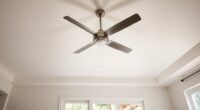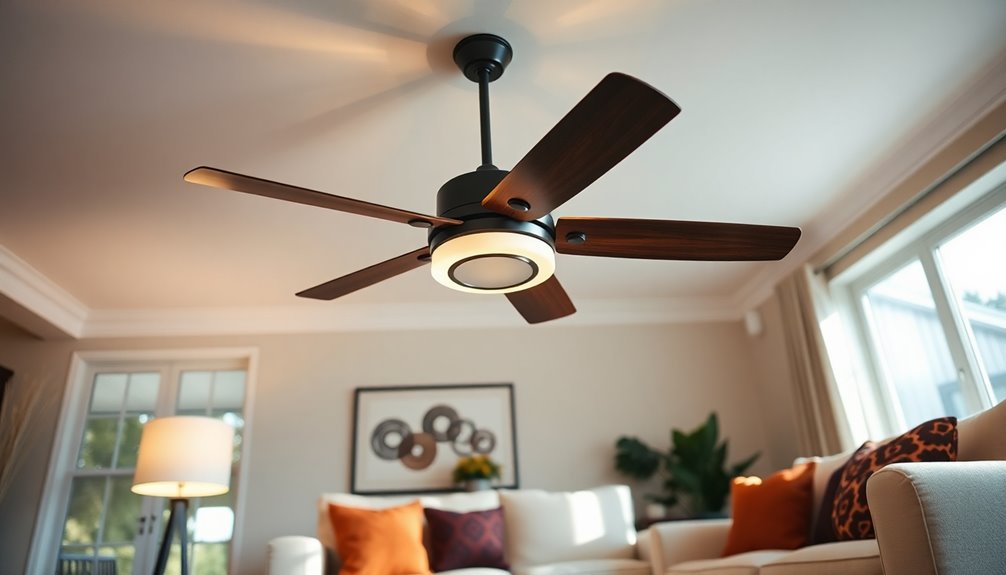A downrod length chart helps you pick the right rod for your ceiling fan by showing suggested lengths based on your ceiling height and room size. It considers factors like lighting, aesthetic style, and safety to guarantee proper airflow and a balanced look. Using this chart makes installation easier and avoids common mistakes. If you want a clear guide that simplifies choosing the perfect downrod, there’s more useful info waiting for you.
Key Takeaways
- A downrod connects the ceiling fan to the motor, positioning it at an optimal height for airflow and safety.
- The downrod length chart matches ceiling height with recommended lengths to ensure proper fan placement.
- Longer downrods are used for higher ceilings, while shorter ones suit lower ceilings for balanced airflow.
- Measuring your ceiling height and room size helps choose the right downrod, preventing blades from tilting or hitting objects.
- The chart simplifies selecting a downrod by visually guiding you to match your room’s dimensions with appropriate fan height.
What Is a Downrod and Why Is It Important?

A downrod is a metal rod that connects your ceiling fan to the motor housing, and it plays a crucial role in both the fan’s function and appearance. It helps position the fan at the ideal height for air circulation and safety. Proper downrod length ensures the fan blades are at the right angle, which affects airflow efficiency. Additionally, the downrod can enhance your room’s aesthetic by aligning the fan with lighting fixtures and other decor elements. If the downrod is too long or short, it can cause the fan blades to tilt improperly, reducing airflow and creating noise. Choosing the correct downrod length ensures your fan operates smoothly, looks balanced, and complements your lighting fixtures for a cohesive look. The correct downrod length also impacts the fan’s overall performance and longevity.
How a Downrod Length Chart Works
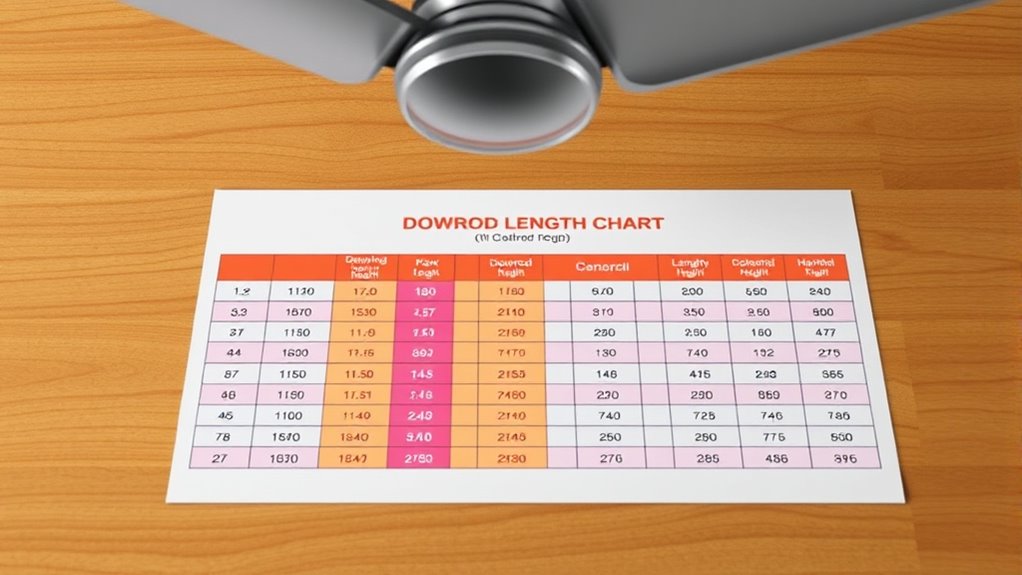
A downrod length chart provides a clear, visual guide to help you select the right downrod size based on your ceiling height and room dimensions. It shows recommended lengths for different ceiling heights, ensuring your fan hangs at the ideal height for comfort and safety. The chart also factors in lighting compatibility, helping you choose a downrod that accommodates existing or planned light fixtures. Additionally, it considers aesthetic considerations, guiding you to select a length that maintains a balanced and attractive look in your space. By following the chart, you avoid issues like fans hanging too low or too high, which can impact both functionality and style. Virtually, it simplifies the decision-making process, ensuring your ceiling fan not only works well but also looks great. Proper installation practices also play a crucial role in achieving optimal performance and safety.
Factors That Influence Downrod Length
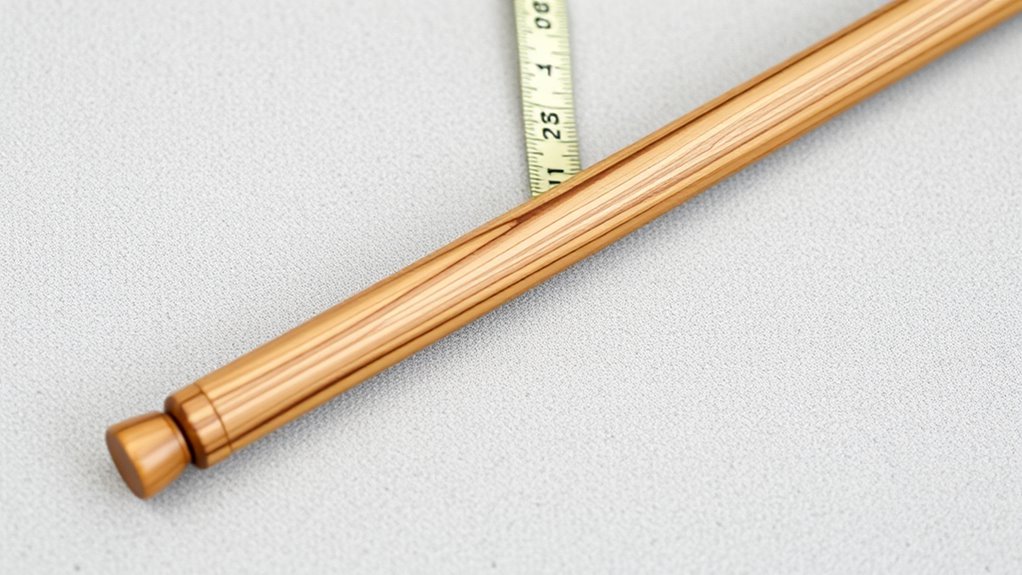
Several factors influence the ideal downrod length for your ceiling fan, affecting both safety and aesthetics. Lighting considerations play a key role; if you have hanging light fixtures, you’ll want a downrod that positions the fan to avoid interfering with the lights or casting unwanted shadows. Aesthetic preferences also matter—some prefer a close-to-ceiling look, while others favor a more dramatic, suspended appearance. The height of your ceiling impacts the choice as well, with higher ceilings often requiring longer downrods to ensure proper airflow and visual balance. Additionally, the room’s overall style influences your decision, as a sleek modern space might call for a different downrod length than a traditional design. All these factors combine to determine the best fit for your space. Understanding AI in Device Performance can help optimize smart fan features for better control and efficiency.
How to Measure Your Ceiling and Room for the Perfect Fit

Start by measuring your ceiling height from the floor to the ceiling to determine the right fan placement. Then, assess the available space in your room to make certain the fan will fit comfortably without obstruction. These measurements help you choose the perfect downrod length for a balanced and functional setup. Additionally, considering noise levels of modern heat pumps can ensure your cooling system operates quietly, enhancing overall comfort.
Measure Ceiling Height
Wondering how to guarantee your ceiling fan fits perfectly? First, measure your ceiling height accurately. Use a tape measure from the floor to the ceiling. For ideal lighting placement and aesthetic considerations, decide how low you want the fan to hang, typically 8-10 feet above the floor. If your ceiling is higher, you’ll need a longer downrod; if lower, a shorter one. Here’s a quick guide:
| Ceiling Height | Downrod Length | Purpose | Notes |
|---|---|---|---|
| 8-9 feet | 5-10 inches | Standard height, functional fan | Maintain 8-9 ft clearance |
| 10-12 feet | 12-24 inches | Higher ceilings, aesthetic focus | Enhance room proportion |
| 12+ feet | 36+ inches | Large spaces, lighting focus | Consider professional install |
Additionally, ensure that the downrod length adheres to recommended guidelines, which help maintain proper airflow and safety standards.
Assess Room Space
To guarantee your ceiling fan fits perfectly and functions properly, you need to accurately measure both your ceiling height and the room’s overall space. Consider your decorating style, as it influences fan placement—modern designs often favor flush mounts, while traditional styles may require longer downrods. Assess the room’s size to ensure the fan’s blades won’t interfere with furniture or walls. Adequate clearance enhances lighting effects, making sure your fan doesn’t block light sources or create unwanted shadows. Measure the width and length of the room, noting ceiling height to determine the ideal downrod length. Understanding fan placement guidelines helps you select the right downrod for optimal airflow and aesthetic balance. Proper assessment ensures your fan complements your decor, maximizes airflow, and optimizes lighting, creating a comfortable, stylish space.
Step-by-Step Guide to Choosing the Right Downrod
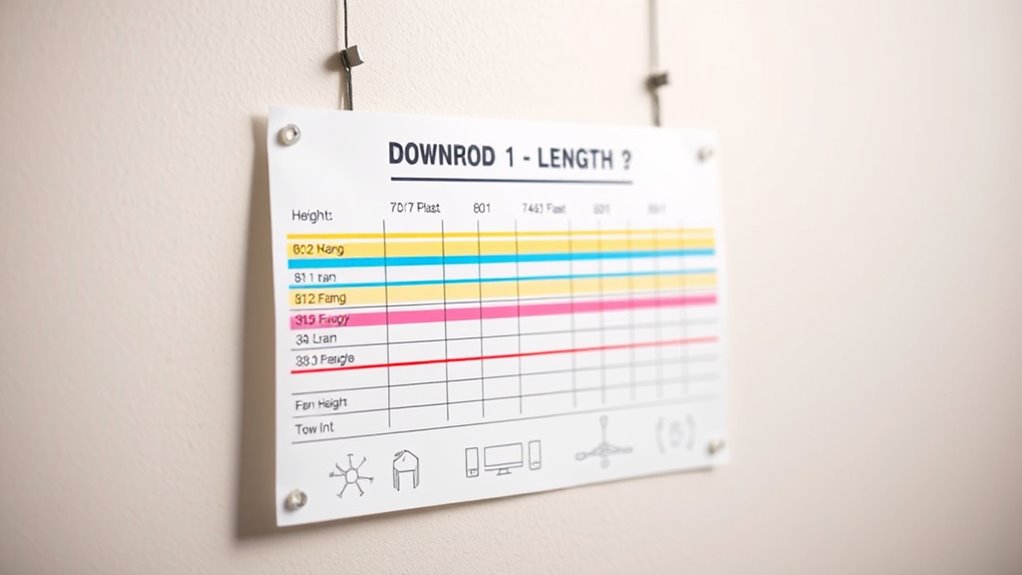
Choosing the right downrod length is essential for achieving a balanced and functional ceiling fan setup. To do this, consider your room’s height, fan size, and aesthetic preferences. Start by measuring the distance from the ceiling to your desired fan height, typically 8-10 inches below the ceiling for ideal airflow. Use this table to guide your choice:
| Design Considerations | Installation Tips |
|---|---|
| Room height | Measure ceiling-to-floor distance |
| Fan size | Ensure proper clearance |
| Aesthetic preferences | Match downrod color/material |
| Ceiling type | Use appropriate mounting hardware |
Keep these factors in mind to make an informed decision, ensuring both functionality and style. Additionally, understanding remote work benefits can help create a more comfortable environment for installing and maintaining your ceiling fan.
Common Mistakes to Avoid When Selecting a Downrod Length

Selecting the wrong downrod length can compromise both safety and airflow, so it’s important to avoid common mistakes during the process. One mistake is ignoring lighting compatibility; a too-short or too-long downrod can interfere with ceiling fixtures or cause uneven lighting. Additionally, overlooking aesthetic considerations can lead to a fan that looks out of place or awkward in your space. Be mindful of the overall room height and design, ensuring the fan and downrod create a balanced appearance. Rushing the measurement process or guessing can result in an unsuitable length that hampers airflow or safety. Take the time to measure accurately and consider both functional and visual factors to select a downrod that enhances your fan’s performance and complements your room’s style. Remember, electric power generation with bike generators can be an efficient way to produce renewable energy when considering electrical components for your home or project.
Frequently Asked Questions
Can I Modify a Downrod Length After Installation?
Yes, you can modify a downrod length after installation, but it’s best to plan for some installation flexibility. If you need a different length, you might need to replace the existing downrod or add extenders. Keep aesthetic considerations in mind, ensuring the new length maintains your ceiling fan’s proper function and appearance. Always turn off power and consult installation instructions or a professional for safe, effective modifications.
Are Adjustable Downrods Better Than Fixed-Length Ones?
Adjustable downrods are better for flexibility, allowing you to customize the fan height for ideal airflow and aesthetics. They offer benefits like easy height adjustment if your ceiling height changes or if you want to fine-tune the fan’s position. Fixed-length downrods have limitations because they can’t be adjusted, which might lead to improper airflow or visual imbalance. So, if you value versatility, adjustable downrods are the smarter choice.
How Does Ceiling Height Affect Downrod Choice?
Think of your ceiling height as the sky, guiding your choice of downrod. For standard ceilings, a fixed length often suffices; taller ceilings call for longer downrods to bring the fan closer to eye level. Ceiling height considerations matter because they influence downrod length adjustments, ensuring ideal airflow and safety. Adjusting the downrod lets you achieve the perfect balance, making your fan both functional and stylish, no matter how high your ceiling soars.
What Materials Are Best for Durable Downrods?
You should select downrods made from materials with high durability and corrosion resistance, like steel or aluminum. Steel offers strength and longevity, especially if it’s powder-coated to resist rust. Aluminum is lightweight and naturally resistant to corrosion, making it ideal for outdoor or humid environments. Both materials guarantee your ceiling fan stays secure and functional over time, even with frequent use or exposure to moisture.
Is There a Standard Downrod Length for All Ceiling Fans?
There isn’t a single standard size for all ceiling fans, as they vary based on room height and fan design. Typically, you’ll find standard sizes like 12, 18, or 24 inches, but custom options are available if your ceiling is particularly high or low. To guarantee ideal airflow and safety, measure your ceiling height and fan size, then choose a downrod length that maintains the fan’s perfect angle and clearance.
Conclusion
So, after all this fuss about measuring and matching, you might think choosing the right downrod is rocket science. Turns out, it’s just about paying attention and avoiding the obvious pitfalls. Who knew? Now, with your new knowledge, you’re practically a ceiling fan expert—ready to conquer any room. Just don’t forget: the perfect downrod might seem small, but it makes a huge difference. Happy hanging!

